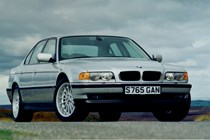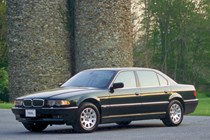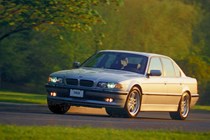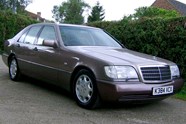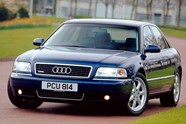
BMW 7-Series Saloon (1994-2002) review
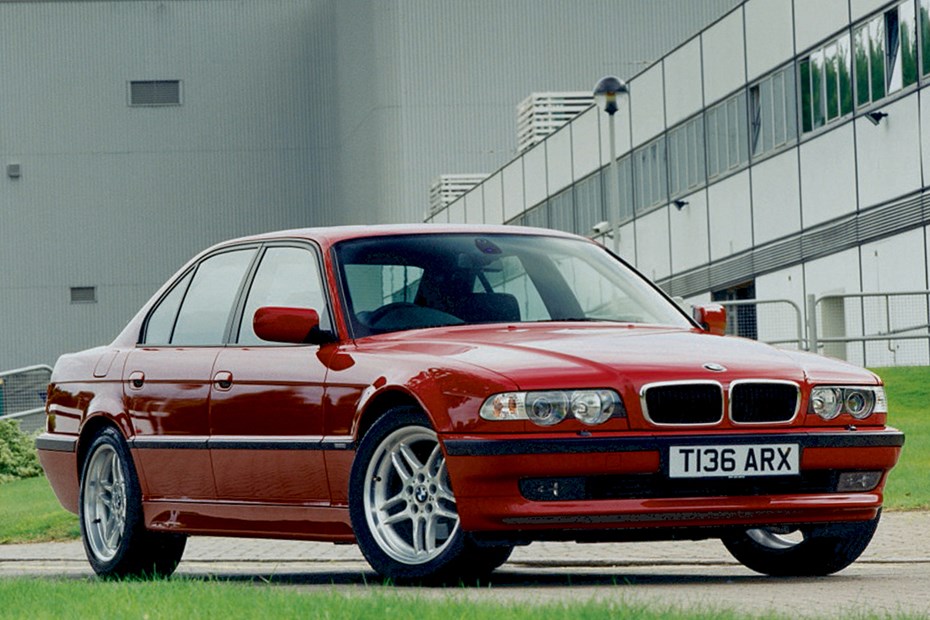
At a glance
| Price new | £38,520 - £75,425 |
|---|---|
| Road tax cost | £360 - £430 |
| Insurance group | 45 - 50 |
Get an insurance quote with

|
|
| Fuel economy | Not tested to latest standards |
| Range | 393 - 486 miles |
| Number of doors | 4 |
| View full specs for a specific version | |
Available fuel types
Petrol
Pros & cons
Performance, refinement.
Running costs.
BMW 7-Series (94-02) rivals
Overview
Launched way back in 1994, the BMW 7 series (or E38 internally) caused a bit of a sensation on its arrival. It featured several industry firsts including safety equipment such as being the first production vehicle to feature curtain airbags and technology-based features such as the first car to offer on-board television. Petrol engines ran from an in-line six 2.8 litre with 190hp through to a 5.4 litre 320hp V12.
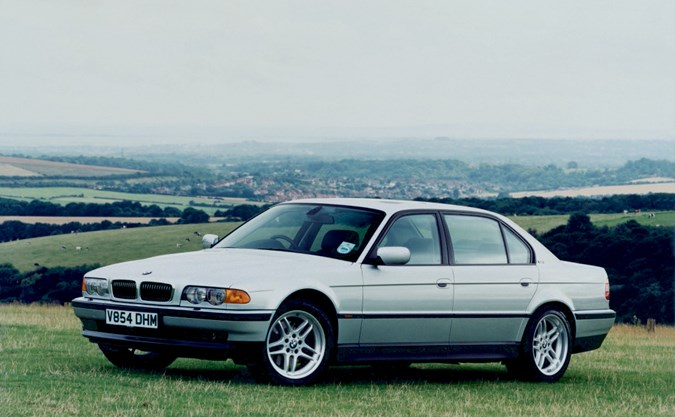
Unlike most traditional luxury large saloons, the E38 could also be fuelled by a large range of diesel engines too – a 2.5-litre with 140hp, a 2.9-litre with 190hp – both in-line sixes – and a turbine smooth 3.9-litre V8 with 240hp.
The traditional BMW driveline of front engine rear drive continued, and transmission options were 5 or 6 speed Getrag manual or 5 speed ZF automatic with torque lock-up feature on 3rd, 4th and top gear. The UK market had the option of two wheelbases with models denoted as ‘i’ for standard or ‘iL’ for the long wheelbase. A limousine version called the L7 was also available in Europe and only in the UK ordering through a vetted BMW special option programme. The off the peg ‘iL’ was found to be more than adequate for diplomatic, corporate or chauffeuring roles.
BMW 7-series E38 known faults and common problems
1. Steering and ride vibrations
Older and well-worn cars can give all sorts of faint vibrations through the cabin and juddering sensations through the steering wheel. The complex front suspension set up includes bushings to combat castor, camber, braking and cornering forces – it’s very difficult to locate exact faults at the kerbside. Rouge traders may try and fob you off with it just needing brake discs or its wheels balancing, so either walk away or barter for a healthy discount if you’re feeling brave. Do some research beforehand though – it’s a very well-known 7 series issue.
2. Vibrations, part 2
On an older or higher mileage vehicle, sit in the rear and ask the seller to drive and apply and back off the throttle at motorway speeds. If you hear a muted thump or feel a slight wobble when the power is applied, you could be budgeting for rear inner driveshaft C.V joint replacement. However, if the sensation is only very slight, ask yourself if you can live with it, as they take a very long time to get worse if driven normally.
3. Oil consumption on six-cylinder petrol
A cute vendor trick is to clean out the exhaust trim with alloy cleaner and a wheel brush to get rid of black tell-tale deposits from where the engine has been burning oil. Take the car for a test drive and give it some beans in 3rd gear, keeping an eye on the rear-view mirror for bluey grey smoke. Upon return, lick your middle finger and lightly run it around the inside of the tailpipe, if the residue is damp and sticky she’s burning oil – walk away!
4. Top-end engine noise on six-cylinder petrol
With routine servicing and a sympathetic driver, the in-line petrol units will plough on forever. If abused or run on the wrong oil they won’t tolerate it for long, so listen for a rhythmic tapping noise that indicates worn cams or followers. If the engine clatters on acceleration, it could be as serious as piston con-rod small-end failure. Also feel for gas pressure escape from the dipstick tube on idle, warning you of excessive crank pressure / piston ring wear.
5. Have a thorough look underneath
Despite the visual condition up top, get underneath and have a thorough look for surface and component corrosion paying special attention to the brake pipes where possible, and for potential water leaks around the carpet and sills while you’re already on the ground.
6. Heating and ventilation
Thoroughly make sure the cabin temperature changes on demand. The servo assisted controls can fail over time causing the car to have a permanently hot or cold interior. You can still get the parts, but the repair is a little costly, time consuming and best left to a trained mechanic.
7. Bodywork condition
The E38 is a well-made machine but can be susceptible to surface corrosion – especially in lighter colours. Pay close attention to edges of wings, along the sills, the windscreen surround and sunroof (if fitted). It’s also worth checking the headlights, which suffer from cracked or broken plastic adjusters internally.
8. Buttons and switches
Don’t feel embarrassed to twiddle every knob and dial for form, function and action. Pay close attention to front seat motors – these seem to either seize up or burn out.
9. ABS or traction warning lamps
Either of the above is an MOT failure and worth mentioning purely as some cars are now well over 25 years old. ABS pumps are particularly common for simply packing up over time.
10. Erratic or stiffening steering at lower speeds
If you notice the wheel rim twitch randomly in your grip or stiffen up at lower revs, less than honest mechanics will tell you that it needs a new steering pump. More likely it could possibly be nothing more than a PAS fluid filter that lives deep inside the oil reservoir. Replacement of the PAS bottle and a fluid flush is usually all that’s required, parts are available and cheap but it’s a messy repair to undertake.
For all the caveats and warnings when buying the E38 7-series, it’s worth remembering that it was one of the best, and most advanced cars in its class when launched. At current prices, the amount you can spend on repairs is unlikely to get a new car of similar character, ability and style – keep reading to see how we rated it when new.



